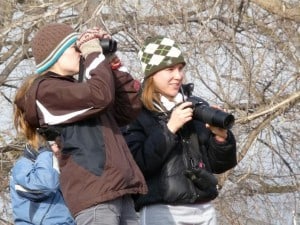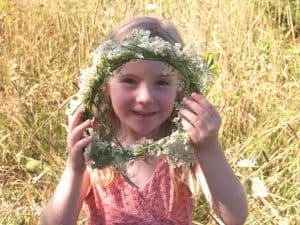How do we raise engaged and concerned citizens in the 21st century? How can we teach our children to care for each other as well as the land, water and other species? Who will be the conservationists of the future when the average child can identify over 300 corporate logos, but only 10 native plants or animals?
A local community-based strategy is taking form to answer these crucial questions. Initiated by Camp Kawartha, a year-round environmental education centre and summer camp, “Pathway to Stewardship” provides a direction forward so that collectively, we can help foster tomorrow’s stewards, today. What is a steward? Someone who tends to and takes responsibility for the well-being of all community members, the human and non-human alike. As the American ecologist Aldo Leopold wrote, we need to cultivate an ethic, which “enlarges the boundaries of the community to include soils, waters, plants, and animals, or collectively: the land.”
Why now?
Warning signals are everywhere these days that something is wrong. Psychologists are pointing to a near epidemic of mental health issues, ranging from anxiety in children and teenagers to alienation and depression in adults. In classrooms across Canada, there has been a surge in the number of children with special needs such as attention deficits and anti-social behaviour. Health care providers have grave concerns about children’s fitness levels and the huge increase in obesity. An increasingly sedentary, indoor lifestyle characterized by too little physical activity and too much screen time means that today’s children may be the first in generations to not live as long as their parents.
Much of the research into the causes and potential solutions to these problems is coming to similar conclusions, including the importance of opportunities to play and explore freely in natural outdoor environments. Among the many benefits of playtime spent in nature are stress reduction, improved mental and physical health, greater creativity, enhanced concentration and conflict resolution skills, higher self-esteem, better problem-solving abilities and a life-long interest in learning.
Providing children with regular positive experiences in the natural world, especially at a young age, is also a powerful way to stimulate a sense of community, of belonging, and a sense of responsibility towards the world around them. By engaging in simple, age-appropriate acts of stewardship, we inspire advocacy for both the human and land community.
Sadly, most childhood experiences in the modern world push children in the opposite direction. Their days are pre-scheduled from the time they awake; we drive them to and from school; and, for “safety’s sake”, we’ve made our schoolyards and many of our parks into sterile environments with little opportunity for creative play or interaction with nature. Our exaggerated sense of risk, often fueled by the media focus on rare incidents of child abduction or abuse, results in unintentional but long-lasting harm to children. It’s no wonder that so many young people today are fearful of strangers, intimidated by nature and feel powerless and disconnected from the world around them.

It’s essential for the future of conservation to cultivate an interest in nature in young people – Drew Monkman
About the Strategy
The Pathway to Stewardship strategy is a community response to these issues, which will be strengthened from further ideas and feedback. Grounded in research in child development and educational theory, it includes many concepts that echo Indigenous knowledge. It is also informed by the thoughts, ideas and insights of local educators and environmental leaders.
The strategy sets benchmarks or specific achievements based on the developmental needs and abilities of children from birth to late teens. For each age group, important principles are provided – many of which apply to all ages – that underpin the benchmarks. All of these integrate with the Ontario School Curriculum. Most importantly, the document identifies local resources to support the achievement of each benchmark. For children four to five, for example, an important principle is developing a sense of the awe and wonder of nature by being outdoors in all seasons. The corresponding benchmark is to visit a favourite outdoor location each week in all seasons. Two simple activities that support the benchmark are participating in nature scavenger hunts and creating a nature table to which items are added each season. Resource providers range from the Peterborough Junior Field Naturalists and Riverview Park and Zoo to the Camp Kawartha Summer Kindercamp.
For children 10 to 11, a core principle is expanding their understanding of the relationships between living things and their habitats. The related benchmark is to explore biodiversity by discovering what lives in a wetland. One suggested activity is to visit a pond and, using a net and magnifier, to try to find at least 10 different organisms that live there. The long list of community resources for this age group includes Kawartha Pine Ridge Public School Board Outdoor Education Centres and the Ontario Federation of Anglers and Hunters (OFAH).
For 16 and 17 year olds, a key principle is the importance of challenging outdoor recreation experiences. The benchmark for this principle is to organize and go on an extended trip (e.g., canoe, hiking) in a wilderness area for at least five days. Activities include planning where and when to go, the gear and food you will need and safety concerns that should be considered. Several key community resources for this age group are Camp Kawartha, Ontario Parks, the BIKE Community Cycling Hub and the Canadian Canoe Museum.
A key component of the Pathway to Stewardship is that everyone in the community has a role to play in fostering tomorrow’s stewards. To this end, the steering committee hopes to seek official endorsement from local groups and agencies such as those mentioned above. Each will be asked how they can support the plan. Gaps in existing resources will also be highlighted. This latter point is especially important, because it will identify a “wish list” of key supports and projects. For instance, these could include a list of local natural areas suitable for visits by the general public and accompanied with maps; access to stewardship mentors and role models (supportive mentors are critically important to help children enjoy outdoor time); designated “nature play” areas on public and private land (such as the one at the Camp Kawartha Environment Centre); training opportunities for parents, teachers and caregivers to facilitate creative outdoor play; and a series of regular neighbourhood walks throughout the community.
Steering Committee
Peterborough is rich in community resources when it comes to experiencing and learning about the natural world. This wealth is reflected in the makeup of the steering committee that guided the writing of the draft document. There is representation from both local school boards, Trent University’s School of Education, Otonabee Region Conservation Authority, Peterborough City-County Health Unit, Sir Sandford Fleming College’s Early Childhood Education program, Riverview Park and Zoo, Camp Kawartha and Kawartha Land Trust. The lead researcher is Cathy Dueck, an environmental and landscape educator and founder of Peterborough GreenUp’s Ecology Park. The committee interviewed more than 75 community leaders from a wide variety of sectors to learn what childhood experiences helped promote their own love of the natural world. They were also asked for their recommendations on how to best cultivate this love in today’s young people.
The Pathway to Stewardship is a call to action to all of us who care for, plan for or work with children – parents and relatives, teachers, community groups, health professionals and government agencies. According to Dueck, “Initial feedback on the Pathway to Stewardship is very encouraging. This project could really galvanize the entire community around a common goal – the present and future well-being of our children.”
For more information, email the organizers at peterboroughpathway@gmail.com. There is also a community consultation being held today, April 14, at the Camp Kawartha Environment Centre (2505 Pioneer Rd., on the Trent University campus). The first session is from 3-5 PM, and a second from 7-9 PM. Everyone is welcome to come and hear about the project and discuss its implementation.
